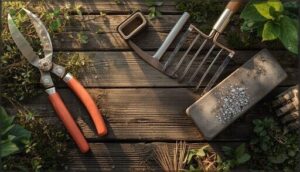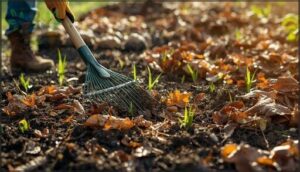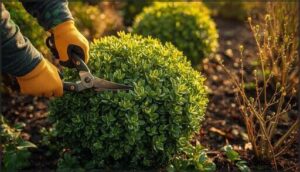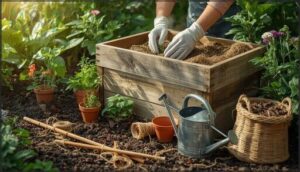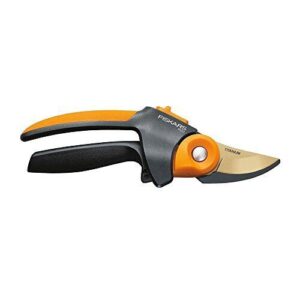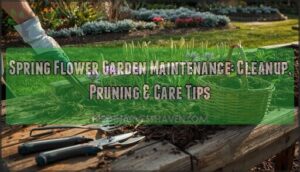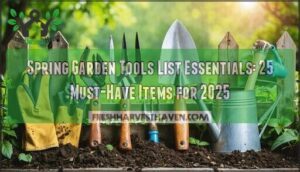This site is supported by our readers. We may earn a commission, at no cost to you, if you purchase through links.
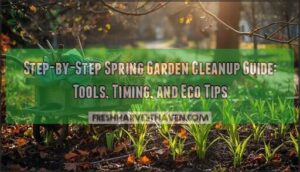
Some gardens wake up in spring looking less like a postcard, more like a battlefield—fallen branches, last year’s leaves, and weeds that wasted no time staking their claim. The secret isn’t found in brute force or endless hours bent over beds, but in a practical, step-by-step approach that brings order and new life to your plot.
With the right tools, a pinch of patience, and a few simple habits, your spring garden cleanup can turn almost any mess into a source of pride. Here’s how you turn what feels like a chore into the highlight of your gardening year.
Table Of Contents
- Key Takeaways
- What Spring Garden Cleanup Involves
- Best Timing for Spring Garden Cleanup
- Essential Tools for Effective Cleanup
- Step-by-Step Spring Garden Cleanup Guide
- Eco-Friendly and Organic Cleanup Practices
- Top 8 Tools for Spring Garden Cleanup
- 1. Swiss Made Garden Pruning Shears
- 2. Fiskars PowerGear Bypass Pruning Shears
- 3. Fiskars Extendable Power Lever Bypass Lopper
- 4. Fiskars Big Grip Garden Cultivator
- 5. Cobrahead Garden Weeding Tool
- 6. Corona Forged Hedge Shear HS 3911
- 7. Heavy Duty Garden Leaf Rake
- 8. Natural Jute Twine Strong Craft String
- Post-Cleanup Maintenance and Planning
- Frequently Asked Questions (FAQs)
- Conclusion
Key Takeaways
- Start your spring cleanup only after consistent 50°F temperatures and dry soil to avoid compacting earth, damaging roots, or disrupting overwintering pollinators that depend on dead plant material for survival.
- Clear debris and prune strategically by removing no more than 20% of perennials at once, using sharp sterilized tools, and composting healthy material while disposing of diseased plants separately to prevent spreading pathogens.
- Refresh garden beds with 2-3 inches of compost followed by fresh mulch to suppress weeds, retain moisture, and improve soil structure—laying the foundation for vigorous spring growth.
- Choose durable, ergonomic tools like bypass pruners, extendable loppers, and cultivators with comfortable grips to reduce fatigue and make cleanup efficient, safe, and sustainable season after season.
What Spring Garden Cleanup Involves
Spring garden cleanup means rolling up your sleeves and getting your hands in the dirt. There are a few important steps that set the stage for a thriving garden all season.
Here’s what you’ll want to focus on first.
Removing Dead Plants and Debris
Kick off your spring garden cleanup by clearing out dead plants, leaf litter, and old perennial stems.
Here’s your garden clean up checklist for a healthier landscape and better disease prevention:
- Remove all dead plant debris for pest control and waste reduction.
- Collect and compost material using proven composting methods.
- Dispose of diseased debris separately to limit carbon impact.
Consider the ideal spring timing to avoid harming beneficial insects.
Pruning Shrubs, Trees, and Perennials
Once the garden debris is sorted, turn your attention to pruning shrubs, trees, and perennials. Use sharp garden shears, hand pruners, or loppers—clean them often for tool sterilization. Keep pruning intensity conservative; removing more than 20% at once can stunt regrowth.
Early spring pruning can improve plant health and appearance. Proper pruning techniques help wounds heal quickly and preserve flowering impact, while improper pruning risks disease or poor plant shape.
Clearing Weeds and Old Mulch
After pruning, turn to weeds and old mulch. Mulch Weed Suppression starts with pulling weeds by hand or using a dedicated weeding tool, then removing decayed mulch harboring seeds and pathogens.
Fresh mulch at 2-3 inches balances Soil Temperature Impact, aids Organic Weed Control, and fosters Mulch Decomposition Rates.
Pre-Emergent Strategies here boost weed control for the entire garden bed.
Refreshing Garden Beds for New Growth
Once weeds and old mulch are cleared, it’s time to breathe new life into your garden beds. Lay down a layer of compost for nutrient-rich soil amendment, then add fresh mulch to lock in moisture and boost drainage. Raised beds benefit from improved soil structure, supporting quick spring growth and strong root development.
Your checklist should include:
- Apply compost for soil amendment
- Top with 2–3 inches of mulch
- Inspect and prep raised beds for drainage improvement
- Confirm even soil preparation in all garden beds
Best Timing for Spring Garden Cleanup
Knowing when to tackle spring garden cleanup can make all the difference. The right timing sets your garden up for strong, healthy growth.
Let’s look at the key things you’ll want to watch for.
Ideal Temperature and Weather Conditions
Ever notice how Spring Garden Cleanup can feel like waiting for science and sunshine to agree? Hold off until daytime highs and soil temperatures hit 50°F for a week straight, avoiding frost risk and soggy soils. Dry, sunny weather and gentle winds help debris dry out fast.
Watch for microclimates—some beds warm up faster than others. Seasonal gardening always rewards patience.
Signs Your Garden is Ready
How do you know it’s the right moment for Spring Garden Cleanup? Nature offers clear cues if you watch closely:
- Soil crumbliness—crumbles in your hand, not muddy
- Nighttime temperatures hovering above 50°F for a full week
- Bloom cues and insect emergence—apple petals drop and new shoots push up
Spot these visual signs, and you’re set for garden preparation.
Why Timing Affects Garden Health
Although it’s tempting to kick off Spring Garden Cleanup at the first sunny spell, the timing shapes everything. Jump in too early and you risk Soil Compaction, damaging beneficial microbes and roots. Wait for Pollinator Emergence—nighttime temperatures near 50°F—so you won’t disrupt insect life. Well-timed Garden Cleanup and Maintenance cut Disease Spread and reduce Frost Risk, ensuring strong, resilient growth.
| Mistimed Cleanup | Ideal Cleanup | Late Cleanup |
|---|---|---|
| —————-: | : | |
| ————–: | : | |
| ————: | ||
| Soil Compaction | Healthy Roots | Disease Risk |
| Lost Pollinators | Bloom Timing | Slow Growth |
| Frost Damage | Safe Emergence | Missed Cues |
| Patchy Growth | Vibrant Beds | Weedy Start |
Essential Tools for Effective Cleanup
Getting your garden in shape starts with having the right tools. The basics should feel comfortable in your hands and ready for any job.
Here are the key essentials you’ll want nearby as you get started.
Pruning Shears and Loppers
Pruning shears and loppers are your garden’s best sculptors—capable of shaping, tidying, and reviving plants with every snip.
Look for hand pruners and loppers with ergonomic design, sharp bypass blades, and durable materials like forged steel or titanium.
Safety features, such as locking mechanisms, and cutting efficiency are essential for healthy pruning and long-lasting gardening tools and equipment.
Rakes and Cultivators
Think of rakes and cultivators as your garden’s workhorses during spring garden clean up. The right rake type—leaf, bow, or level-head—makes yard work smoother and less tiring, especially with ergonomic designs.
Reliable cultivators turn soil prep from a chore into a breeze, boosting performance and cutting effort. Keep these garden tools clean for excellent, season-long results.
Safety Gear and Cleaning Supplies
How prepared are you for spring clean up? The right PPE—think gloves, sturdy shoes, and safety goggles—means fewer injuries and more confidence.
Today’s garden tools should be paired with cleaning trends like chemical alternatives for sanitizing. Tool sanitization after spring cleaning isn’t just habit; it’s injury prevention, disease reduction, and a smarter approach to spring garden clean up and gardening supplies.
Step-by-Step Spring Garden Cleanup Guide
Getting your garden in shape for spring doesn’t have to feel overwhelming. With a step-by-step approach, you can tackle each task with confidence.
Here’s how to get started and what to focus on next.
Preparing Your Tools and Checklist
A fresh start to spring garden clean up means more than just digging in; it begins with your tools. Cleaning blades, sharpening edges, and promptly replacing worn-out gear set the tone for a smooth season.
Investing in ergonomic tools pays off, and a thorough spring garden checklist ensures nothing gets left behind. Efficiency and garden health both depend on this simple preparation.
Clearing Debris and Leaves
Once your checklist and tools are ready, go after the real clutter: leaf litter and winter debris. Raking leaves away in early spring prevents fungal buildup and opens sunlight to new shoots.
For habitat preservation, tuck thick leaf layering along your garden’s edges instead of bagging. Smart debris disposal and mulch management after storm cleanup keep your spring garden clean up efficient and eco-friendly.
Cutting Back Perennials and Shrubs
With debris cleared, it’s time to focus on pruning and trimming. For healthy regrowth, use sharp hedge shears for perennial stems and apply Shrub Rejuvenation techniques:
- Cut at proper heights—no more than 25% for perennials.
- Time it right for better regrowth and disease prevention.
- Always target outward-facing buds for stronger, balanced shrubs.
Soil Amendment and Mulching
Once you’ve trimmed back your perennials, focus on feeding your soil. Start with a spring soil test to pinpoint what your beds need most.
Spread a 2-inch layer of rich compost—your best bet for boosting organic matter, water retention, and plant health. Top with mulch. Choose mulch types that match your soil’s needs, and refresh yearly for steady improvement.
Cleaning Patios, Decks, and Furniture
In spring clean up, tackling your patio and deck maintenance pays off fast. Wipe down patio furniture with eco-friendly cleaners, targeting mold and mildew prevention for wood and wicker. Deck power-washing works wonders for patio stain removal. For a relaxing outdoor space that lasts, remember:
- Match furniture material care to each surface
- Clear leaves and debris
- Protect finishes from weather damage
Eco-Friendly and Organic Cleanup Practices
Caring for your garden means thinking about more than just plants. If you want your cleanup to be greener and safer, a few habits can make all the difference.
Here’s what to keep in mind as you get started.
Protecting Beneficial Insects and Pollinators
Did you know rushing cleanup can wipe out a huge number of garden pollinators? Two-thirds of beneficial insects overwinter in old stalks, leaves, and hidden brush.
If you wait for true warmth and use native plants, you’ll encourage healthy Habitat Retention, smart Timing Practices, and create nesting structures—simple changes that turn your beds into essential Ecofriendly Gardening Practices for insect conservation.
Composting Plant Debris
Tossing those cuttings and leaves into a compost pile does far more than tidy up your yard. Composting after spring garden cleaning slashes waste, keeps landfill methane at bay, and feeds your garden rich nutrients.
Each scoop of finished compost turns debris into dark, crumbly gold—fuel for soil improvement, natural mulching, and real compost benefits grounded in ecofriendly gardening.
Cleaning Tools to Prevent Disease
Ever notice how neglected pruning shears spread more than just wear and tear? Tool sanitation is your frontline defense against disease transmission in the garden.
For the best results:
- Clean Gardening Tools after every use.
- Use proven disinfectants for maximum efficacy.
- Prioritize regular cleaning frequency—especially before Spring Garden Cleaning.
- Maintain your tools for longer life and healthy, organized plant care.
Reducing Chemical Use in The Garden
Cutting back on chemicals isn’t just about following a trend—it’s a shift that truly benefits soil health and your wallet. Organic Gardening Techniques like using natural predators or composting boost beneficial insects and save on chemical costs.
Lean on Environmental Gardening and Sustainable Gardening Methods to prevent water contamination, and choose organic pesticides for weed prevention that respects both your garden and the earth.
Top 8 Tools for Spring Garden Cleanup
Having the right tools can make spring garden cleanup a whole lot easier. A few favorites have stood the test of time for seasoned gardeners.
Here are the top essentials you’ll want close at hand this season.
1. Swiss Made Garden Pruning Shears
A great spring garden hinges on the right tools, and Swiss Made Garden Pruning Shears are the best available for precise, fatigue-free cutting. With hardened steel blades and forged aluminum grips, these shears combine excellent Cutting Performance with an Ergonomic Design that eases long pruning and trimming sessions.
Sharp, consistently aligned blades slice cleanly through thick stems, making hedge shears a pleasure, not a chore. Rely on their Brand Certifications, easy Tool Maintenance, and premium Blade Material to handle your spring garden preparation with confidence.
Best For: Gardeners and landscaping professionals who want reliable, precise, and comfortable pruning shears that will last for years.
- Outstanding cutting power and sharpness for thick branches and dense stems
- Ergonomic, fatigue-reducing design with durable materials and replaceable parts
- Backed by lifetime warranties and industry certifications for quality and longevity
- Heavier and pricier than most other pruning shears on the market
- Regular maintenance is needed to keep blades sharp and springs functional
- May feel bulky for those with very small or very large hands
2. Fiskars PowerGear Bypass Pruning Shears
When your spring garden preparation calls for real cutting power, you’ll want Fiskars PowerGear Bypass Pruning Shears within reach. Backed by high consumer ratings and recognized ergonomic design, these pruners easily slice through small branches while keeping wrist strain at bay.
The precision-ground blade stays sharp long past the first yard clean up, and a handy safety lock keeps accidents at zero. With smart safety features and proven blade durability, these shears deliver stress-free pruning—perfect for reliable Spring Clean Up and trusted gardening tips.
Best For: Gardeners who want comfortable, powerful pruning with minimal hand strain, especially those with hand or wrist issues.
- PowerGear design gives extra cutting strength for easier, sharper trims.
- SoftGrip handle and lightweight build make it comfortable for long use.
- Safe, well-designed blade and locking system help prevent accidents.
- May feel too big for small hands and isn’t left-hand friendly.
- Locking mechanism and plastic gears can break over time.
- Blade may need sharpening after heavy use, and isn’t as tough as top-tier steel.
3. Fiskars Extendable Power Lever Bypass Lopper
If you want reach and strength together, the Fiskars Extendable Power Lever Bypass Lopper is the one you’ll grab for odd-angled branches and stubborn stems. With telescoping grips and ergonomic design, you get clean, confident pruning—plus less fatigue during yard cleanup.
The cutting capacity lets you tackle limbs up to 1.75 inches thick. Its shock-absorbing bumper takes the sting out of every snip. Factor in the full lifetime warranty and solid market comparisons, and it’s a true workhorse for spring gardening.
Best For: Gardeners who want more reach and less effort for trimming hard-to-reach or thick green branches.
- Power-lever tech and non-stick blades cut branches with much less effort.
- Telescoping handles give you up to 3 feet of extra reach for high or awkward spots.
- Cushioned grips and shock-absorbing bumper keep hands comfortable during long jobs.
- The wide handle opening can be awkward in tight spots.
- Not great for branches thicker than 1.75 inches or for very long-distance cuts.
- Some users report the plastic locking mechanism gets brittle over time.
4. Fiskars Big Grip Garden Cultivator
After wrangling thick limbs, you’ll appreciate the Fiskars Big Grip Garden Cultivator for quick soil preparation and weeding. Its ergonomic design—with a padded grip and rust-resistant cast-aluminum head—makes garden cleanup easy on the hands, even in raised beds or crowded spots.
Consumer feedback consistently praises its comfort and efficiency, especially in loosening compacted soil. Safety features, like the bright orange tip and non-slip handle, make it harder to lose in the shuffle of gardening tools and supplies during spring garden organization.
Best For: Gardeners who want a comfortable, durable hand tool for quick soil preparation, planting, and weeding—especially in raised beds or tight spaces.
- Padded, ergonomic handle reduces hand fatigue and offers a secure grip
- Rust-resistant cast-aluminum head and offset tines efficiently loosen and aerate soil
- Bright orange tip and hang hole improve visibility and storage
- Not ideal for deep digging or use in dense, rocky, or heavily compacted soils
- Potential chemical exposure requires handwashing after use due to Proposition 65 warning
- Lacks a sheath or protective cover for safer storage
5. Cobrahead Garden Weeding Tool
If your knees groan at the thought of yet another dandelion, the Cobrahead Garden Weeding Tool brings relief. Its ergonomic weeding design mimics how your hand naturally pulls weeds, cutting effort and strain.
Versatility performance is a real draw—this tool loosens tough roots, edges beds, and stirs compact soil, all while leaving neighboring plants undisturbed.
Durable and dependable, it’s a best-seller in gardening tools and supplies, proving its market adoption. For ecofriendly gardening, its precision helps protect soil structure and beneficial insects.
Best For: Gardeners of any experience level looking for a comfortable, eco-conscious tool that makes weeding and soil prep easier on the hands and back.
- Curved blade easily cuts through compacted soil and tough roots without disturbing nearby plants.
- Recycled plastic handle and steel construction provide comfort, durability, and a lower environmental impact.
- Highly rated for ergonomic design, helping prevent knee and back pain during garden work.
- Not ideal for heavy-duty or large-scale garden projects; best for home gardening.
- Requires manual effort, which can be tiring for bigger weeding jobs.
- Costs more than some basic hand weeders, and may need extra tools for deep or large weeds.
6. Corona Forged Hedge Shear HS 3911
For pruning shrubs or shaping hedges during spring garden cleanup, the Corona Forged Hedge Shear HS 3911 is tough to beat. Blade durability stands out—you’ll sharpen less, trim more, and enjoy a smooth cut even years down the line.
Wooden grips feel sturdy and comfortable, taking the sting out of longer jobs, while the limb notch boosts cutting capacity for thicker branches.
Factor in the lifetime warranty and fair pricing, and you’re getting reliable garden cleanup and organization plus peace of mind.
Best For: Home gardeners or DIY landscapers who want a durable, low-maintenance hedge shear that tackles everything from fine shaping to occasional thick branches.
- Forged, resharpenable blades stay sharp for years and handle both shrubs and thicker branches with ease.
- Comfortable wooden handles with rubber grips make longer trimming jobs less tiring.
- Lifetime warranty backs up its reputation for lasting decades in regular use.
- Handles are a bit heavy and may cause fatigue over extended sessions.
- Not ideal for very thick branches—loppers or saws are still needed for heavy-duty cuts.
- Occasional blade gaps or dents may affect performance if abused.
7. Heavy Duty Garden Leaf Rake
Every smart gardener counts on a heavy-duty leaf rake when tackling spring garden clean up. Rake durability is essential—steel-tined, ergonomic rakes last over a decade and keep fatigue at bay, especially over bigger lawns.
Wide heads clear 3,900 square feet per hour, meaning less time raking and more time planning your next move.
As leaf rakes drive seasonal cleanup market trends, they remain unbeatable for cleanup efficiency. Trust a reliable rake to simplify garden cleanup and organization all spring.
Best For: Homeowners and landscapers who need a sturdy, efficient rake for tough spring yard cleanup and heavy-duty leaf removal.
- Built to last with steel tines and a strong wood handle for years of reliable use
- Wide 24-inch head quickly covers large areas, reducing overall raking time
- Excellent at clearing leaves and thatch, boosting lawn health in one pass
- Some assembly may be required, but instructions aren’t always included
- Not ideal for those seeking a lightweight rake or for users with limited strength
- Occasional reports of incomplete or damaged products upon delivery
8. Natural Jute Twine Strong Craft String
Natural jute twine brings more to your spring clean up than meets the eye. Eco-friendly twine is strong enough for everyday garden applications—training tender seedlings or tying up unruly vines—yet gentle and biodegradable, breaking down in just months for truly ecofriendly gardening.
Jute Biodegradability prevents buildup, while modern twine strength easily tackles seasonal cleanup jobs. No wonder the jute market keeps rising.
For spring gardening tips, stash a roll; it’s essential whenever you need swift, sustainable plant support.
Best For: Gardeners, crafters, and eco-conscious DIYers who want a reliable, earth-friendly string for light projects and creative uses.
- Biodegradable and compostable for sustainable gardening.
- Soft yet strong, with a pleasant natural texture.
- Versatile—ideal for crafts, gift wrapping, and garden support.
- Thinner than some other twines, so it may break under heavy-duty use.
- Prone to shedding small fibers during handling.
- Not suitable for projects requiring strong tension or long-term durability.
Post-Cleanup Maintenance and Planning
Now that the heavy lifting is done, it’s time to keep your garden in top shape. Good habits make all the difference once cleanup is over. Here’s what to keep an eye on next.
Scheduling Regular Garden Tasks
Think garden upkeep is just once and done? Regular scheduling turns chaos into control. Weekly Maintenance—like mowing and quick weeding—keeps things tidy. Monthly Inspections help catch problems before they grow.
And don’t forget Annual Planning; it’s the secret ingredient for a thriving landscape. Smart Task Prioritization and practical Seasonal Gardening Tips make every spring clean up and garden maintenance effort count.
Monitoring for Pests and Diseases
Wondering why that one leaf looks odd or new holes keep appearing? Smart gardeners know that regular pest identification, disease prevention, and thoughtful vector control keep spring gardens humming. Embrace IPM strategies, adjust your monitoring frequency, and protect biodiversity. Fostering beneficial insects and pollinators means you’re not just gardening for wildlife—you’re safeguarding your own green investment.
| Monitoring Frequency | Action | Biodiversity Benefit |
|---|---|---|
| Weekly | Inspect leaves & stems | Early pest find; aids wildlife |
| Bi-weekly | Check for slime/damage | Reduces disease; protects pollinators |
| Monthly | Document changes | Guides IPM tweaks; builds habitat |
| After storms | Focus on edges | Catches vectors; boosts resilience |
| New plantings | Quarantine, survey | Prevents outbreaks; preserves native species |
Planning New Plantings and Design Adjustments
Ready to plant after your cleanup? Let spring’s fresh start prompt a savvy mix of classic and trending ideas. Jot down frost date reminders, then use garden planning tools to time new plantings.
This year’s garden trends? Try:
- More edible garden beds
- New plant varieties for resilience
- Smart design adjustments inspired by expert gardening tips and advice
Frequently Asked Questions (FAQs)
How do I safely dispose of garden waste?
They say, “waste not, want not.” Composting methods turn leaf litter into garden gold, but watch for hazardous waste and invasive species.
Follow local recycling policies, volume limits, and never mix chemicals—sustainable gardening hinges on smart yard chores.
What plants benefit most from spring fertilizers?
Flowering shrubs like hydrangeas and lilacs, vegetable crops such as tomatoes and leafy greens, fruit trees, cool-season lawns, and container annuals all respond strongly to spring fertilization—boosting bloom rates, yields, and overall vigor throughout the growing season.
Are there common cleanup mistakes to avoid?
Like trying to clean before the guests leave, starting spring yard preparation too early disturbs leaf litter and perennial stems.
Pruning errors, mulching mistakes, chemical overuse, timing issues, and poor tool hygiene are common spring clean up pitfalls.
How can I prevent soil compaction during cleanup?
Limit foot traffic on garden bed preparation areas during spring clean up. Work only when soil moisture levels allow crumbling, not sticking.
Use organic matter and mulch for lawn maintenance while encouraging biological activity through proper tool selection.
Should I water my garden after spring cleanup?
Water breathes life back into your freshly cleaned beds. Check soil moisture first—if dry down five to six inches, give plants a good soak.
Proper irrigation timing encourages root growth and a healthy spring awakening.
Conclusion
Funny how the garden that felt like a burden in March becomes your favorite weekend retreat by May. That shift doesn’t happen by accident—it’s the result of your spring garden cleanup guide put into action, one wheelbarrow at a time.
The tools are simple, the steps are clear, and the work pays dividends all season long. Your garden wasn’t asking for flawlessness. It was asking for attention, and you delivered.
- https://www.udel.edu/academics/colleges/canr/news/2025/march/spring-garden-and-landscape-sanitation/
- https://nhaudubon.org/spring-garden-cleanup-supporting-pollinators-and-biodiversity/
- https://www.biocycle.net/composting-industry-stats/
- https://giecdn.blob.core.windows.net/fileuploads/audience/issues/2024/1/16/gc-jan-2024-lr.pdf
- https://www.consumerreports.org/health/food-contaminants/produce-without-pesticides-a5260230325/



